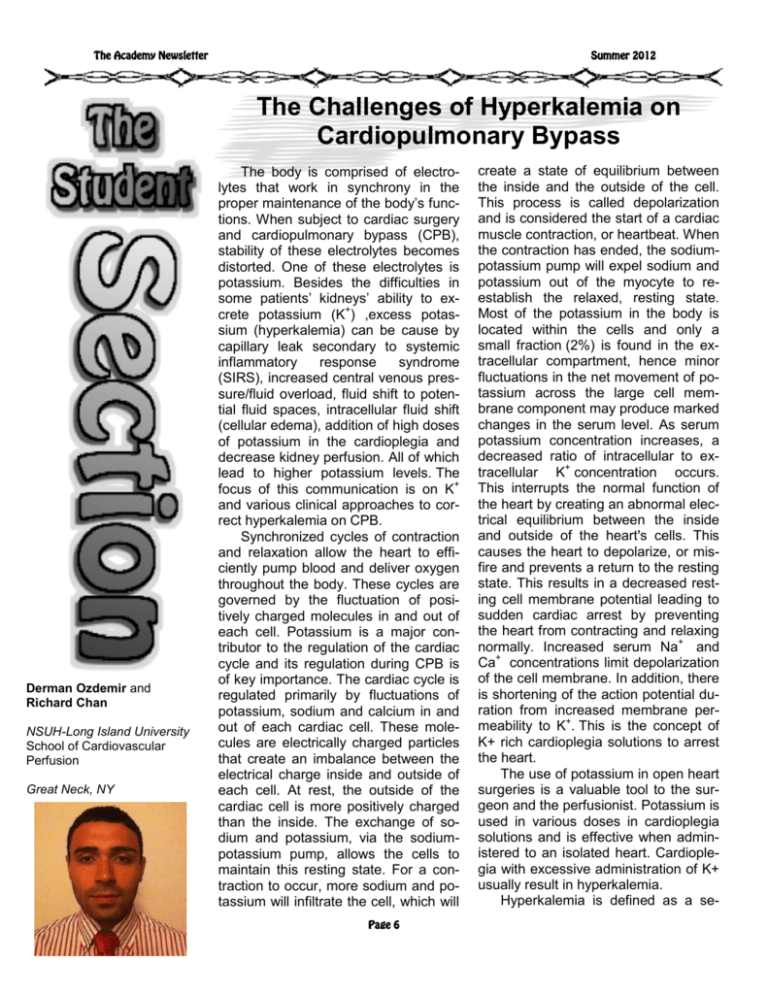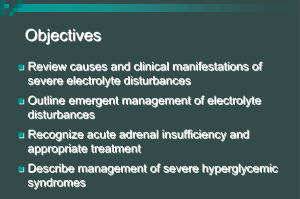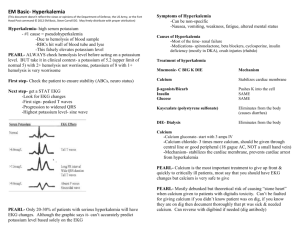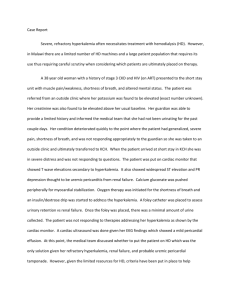The Challenges of Hyperkalemia on Cardiopulmonary Bypass
advertisement

The Academy Newsletter Summer 2012 The Challenges of Hyperkalemia on Cardiopulmonary Bypass Derman Ozdemir and Richard Chan NSUH-Long Island University School of Cardiovascular Perfusion Great Neck, NY The body is comprised of electrolytes that work in synchrony in the proper maintenance of the body’s functions. When subject to cardiac surgery and cardiopulmonary bypass (CPB), stability of these electrolytes becomes distorted. One of these electrolytes is potassium. Besides the difficulties in some patients’ kidneys’ ability to excrete potassium (K+) ,excess potassium (hyperkalemia) can be cause by capillary leak secondary to systemic inflammatory response syndrome (SIRS), increased central venous pressure/fluid overload, fluid shift to potential fluid spaces, intracellular fluid shift (cellular edema), addition of high doses of potassium in the cardioplegia and decrease kidney perfusion. All of which lead to higher potassium levels. The focus of this communication is on K+ and various clinical approaches to correct hyperkalemia on CPB. Synchronized cycles of contraction and relaxation allow the heart to efficiently pump blood and deliver oxygen throughout the body. These cycles are governed by the fluctuation of positively charged molecules in and out of each cell. Potassium is a major contributor to the regulation of the cardiac cycle and its regulation during CPB is of key importance. The cardiac cycle is regulated primarily by fluctuations of potassium, sodium and calcium in and out of each cardiac cell. These molecules are electrically charged particles that create an imbalance between the electrical charge inside and outside of each cell. At rest, the outside of the cardiac cell is more positively charged than the inside. The exchange of sodium and potassium, via the sodiumpotassium pump, allows the cells to maintain this resting state. For a contraction to occur, more sodium and potassium will infiltrate the cell, which will Page 6 create a state of equilibrium between the inside and the outside of the cell. This process is called depolarization and is considered the start of a cardiac muscle contraction, or heartbeat. When the contraction has ended, the sodiumpotassium pump will expel sodium and potassium out of the myocyte to reestablish the relaxed, resting state. Most of the potassium in the body is located within the cells and only a small fraction (2%) is found in the extracellular compartment, hence minor fluctuations in the net movement of potassium across the large cell membrane component may produce marked changes in the serum level. As serum potassium concentration increases, a decreased ratio of intracellular to extracellular K+ concentration occurs. This interrupts the normal function of the heart by creating an abnormal electrical equilibrium between the inside and outside of the heart's cells. This causes the heart to depolarize, or misfire and prevents a return to the resting state. This results in a decreased resting cell membrane potential leading to sudden cardiac arrest by preventing the heart from contracting and relaxing normally. Increased serum Na+ and Ca+ concentrations limit depolarization of the cell membrane. In addition, there is shortening of the action potential duration from increased membrane permeability to K+. This is the concept of K+ rich cardioplegia solutions to arrest the heart. The use of potassium in open heart surgeries is a valuable tool to the surgeon and the perfusionist. Potassium is used in various doses in cardioplegia solutions and is effective when administered to an isolated heart. Cardioplegia with excessive administration of K+ usually result in hyperkalemia. Hyperkalemia is defined as a se- The Academy Newsletter Summer 2012 rum potassium level which exceeds the normal blood potassium level of 5.5 mEq/L. Excessive administration of potassium enriched cardioplegic solutions is one of the causes for hyperkalemia during CPB. One of the most common causes of hyperkalemia is poor kidney function. Kidneys are responsible for measured serum potassium levels and removing excess amounts. When the kidneys are dysfunctional or not functioning well, it will lead to high levels of K+. Hyperkalemia can also occur with the use of older units of blood or packed cells, and in patients with uncontrolled diabetes. Aged blood products lead to hyperkalemia with longer periods of storage, K+ leaks into the supernatant as a result of fracture red blood cell membranes from aging and decreased synthesis of adenosine triphosphate (ATP). The magnitude of this leak increases with duration of storage. Irradiation of blood to inactivate T-lymphocytes and minimize the risk for graft vs. host disease enhances K+ leakage from red cells as a result of subtle membrane injury. Depending on the conditions, the supernatant of stored red blood cell units may contain greater than 60 mEq/L K+. When fresh PRBCs are unavailable, the risk for post -transfusion hyperkalemia can be minimized by washing the cells and decreasing the amount of additive solution. In addition, uncontrolled diabetes will cause hyperkalemia because diabetic patients lack the insulin required to breakdown the excess glucose in the blood. High glucose levels affect the body negatively in two ways. The lack of insulin facilitates the breakdown of fat cells releasing ketones into the blood, making it acidic (ketoacidosis). The ketoacidosis coupled with high glucose blood levels cause potassium to shift out of the cells into the extracellular space. High glucose levels also hinder the kidneys ability to excrete potassium in the urine. Potassium being forced out of the cells and the kidneys not removing the excess potassium via urine leads to hyperkalemia. Prevention is first step in making sure hyperkalemia does not occur on CPB. Maintaining renal function on CPB, being attentive during cardioplegia delivery, giving fresh blood when possible or using a cell washers to wash cells, and making sure a diabetic patient is properly medicated before surgery are all preventative measures that should always be taken. These preventative measures are helpful but it cannot always prevent hyperkalemia from occurring and treatment needs to be initiated. Pharmacological treatment is usually the first step taken to cor- rect hyperkalemia. Normal pharmacological treatment of hyperkalemia is as follows: 1. 20 units of insulin which is used to drive the potassium into the cell, thus insulating the myocardium from high potassium levels, and 25 g of dextrose or glucose to replace the glucose driven off with administration of insulin. The glucose will further promote the movement of K+ from extracellular to intracellular compartments. 2. 500 mg to 1 g of calcium chloride which is used to activate the receptor sites of the potassium pumps on the cell membranes and to replace the serum calcium which will be driven into the cell upon administration of insulin. 3. 50 mEq sodium bicarbonate which will provide intracellular binding sites for the potassium in the form of potassium carbonate. This will correct the acidosis resulting from the shift of hydrogen ions from inside the cell to the extracellular space as electrical equilibrium is maintained. When pharmacological treatment fails during CPB, alternatives such as zero-balance ultrafiltration (ZBUF) can be used. The following is a case report that shows the successful treatment of hyperkalemia during CPB, after failed pharmacological treatment, with the use of Z-BUF. The patient is an 84-year-old Caucasian female with a past medical history of aortic stenosis, hypertension, and hypercholesterolemia who presents for aortic valve replacement. No previous medical history of diabetes or impaired kidney function exists. The bypass time for the case was 113 minutes with an aortic cross clamp time of 84 minutes. The preoperative potassium level was 4.2 mEq, the hematocrit was 31 and all other electrolytes values were within normal limits. After bypass was instituted and the patient was cooled to 32°C, the mean arterial blood pressure was kept above 70 mmHg, with the use of flow above 4.0 L/min and by infusion of phenylephrine. After aorta was cross clamped, 2000 mL of 8:1 blood cardioplegic solution at 4.5°C containing 120 mEq/L of potassium chloride was infused into the aortic root to produce electromechanical arrest. Following cardioplegia delivery, the potassium level increased to 5.9 mEq and the hematocrit dropped to 19. A unit of packed red blood cells was added and the hyperkalemia (range 5.5-6.0 mEq) continued throughout the majority of the case. During rewarming, recognition was that it would be difficult to wean off bypass with elevated potassium Page 7 Continued on Page 8 The Academy Newsletter Summer 2012 Continued from Page 7 levels. A pharmacological treatment regimen was started and 10 units of insulin, 500 mg calcium chloride, and 50 mEq sodium bicarbonate were given sequentially at 20 minute intervals. 30 minutes after the sodium bicarbonate was given, the potassium level was still elevated at 5.9 mEq. At this time, a decision was made to use Z-BUF to try to correct the hyperkalemia. Z-BUF is a technique using a hemoconcentrator. First, the patient is diluted with an isotonic electrolyte solution without K+. which will result in a lower value of K+ within the body. The amount added is removed via hemoconcentration as more dilutional volume is added until the patient reaches the desire electrolyte ( K+ ) value. The net balance of electrolytes from volume added to volume removed is zero hence the term “zero-balance” ultrafiltration. For example, in the case presented, 500mL of solution was added to the extracorporeal circuit diluting the patient’s K+ value from 5.9 mEq to 5.5 mEq. During onset and early period of CPB, there was no urine production, which indicates poor kidney function. However, once the patient was diluted and the Z -BUF technique was put into effect, the hemodilution and due to more time had elapsed on CPB, urine production began and steadily throughout the remainder of the CPB. Hemoconcentration is only one of the concepts that can be used in the treatment of hyperkalemia and its use in this case report demonstrated its effectiveness. With the knowledge that the patient would experience hyperkalemia upon CPB initiation and cardioplegia administration, a pharmacological treatment regimen involving more aggressive diuretics could have been employed earlier during CPB to stimulate kidney function. Continuous ultrafiltration (CUF) from the beginning of the CPB would have reduced fluid shift to the third space, extra vascular and intracellular spaces to reveal a more accurate K+ level. This would also prevent any K+ rebound once the patient was weaned off CPB. Perhaps a more aggressive approach to correct the hyperkalemia would be a hybrid treatment regimen using both pharmacological and hemoconcentration methods simultaneously. Sodium bicarbonate could have been administered earlier, CUF and Z-BUF initiated immediately which may have eliminated the need for insulin. The pharmacological approach used in this case may not have worked effectively due to the fact that the insulin given was driving the K+ into the intracellular space which may already have overloaded binding sites. Also, the K+ level in the intracellular space may already be higher or equal to the level in the extracellular spaces. During CPB, hyperkaleimia cause from dysfunctional kidneys. fluid shifts ,systemic inflammatory responses and addition of large doses of K+ for cardioplegia were discussed. In a routine CPB case, K+ control maybe treated with drugs. In other cases, such as diabetic patients, when large amount of K+ is used, unusual level of inflammatory levels , fluid shift and donor blood transfusion, hyperkaleima may present a challenge. A hybrid approach is suggested. A combination of CUF, Z-BUF and pharmacologic treatment maybe the approach in getting hyperkalemia under control within a shorter clinical time frame and may also prevent rebound hyperkaleimia in the post operative period. Pharmacological treatment is one of the accepted methods used to treat hyperkalemia on CPB but the case presented shows that Z-BUF had to be used to decrease potassium levels. And the patient presented was without renal disease was not a diabetic but had hyperkalemia during CPB which could not be pharmacologically treated. Using Z-BUF approach provided immediate results in the treatment of hyperkalemia. References: Gravlee, G.P, Davis, R.F., Stammers, A.H., Ungerleider, R.M. (eds). (2008). Cardiopulmonary Bypass: Principles and Practice. Philadelphia: Lippincott Williams. James, W.E., Berl, T., Tucker, C. (eds). (1982). Fluid, Electrolyte and Acid-Base Disorders, Vol. II. Parker, Colorado: Postgraduate Institute for Medicine. Lampard J.R., Couves C.M. (1970). Observations of serum potassium in patients undergoing cardiopulmonary bypass. Can Med Assoc J.. 102, pp.61-64. Mayo Clinic Staff, Wilkinson J. (2011). High potassium (hyperkalemia) [online]. Available from: <http:// www.mayoclinic.com/health/hyperkalemia/MY00940>. [Accessed 2012]. Mohrman, D.E., Heller, L.J. (eds). (2002). Cardiovascular Physiology. New York: McGraw-Hill. Rose, B.D. (2001). Clinical Physiology of Acid-Base and Electrolyte Disorders. 5th. ed. New York: McGraw-Hill. Weber, D.O., Yarnoz, M.D. (1982). Hyperkalemia Complicating Cardiopulmonary Bypass: Analysis of Risk Factors. Ann Thorac Surg. 34, pp.439-445. Page 8








